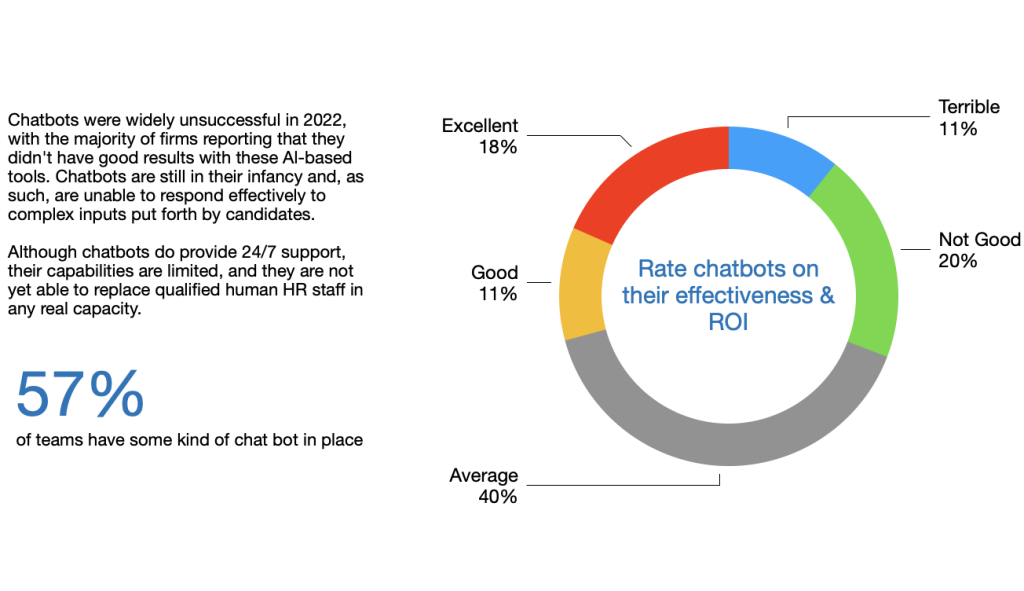Gartner recently released their Hype Cycle for 2022. The Hype Cycle is a theory around the 5 phases of emerging technologies. Chatbots fell into Phase 3, the Trough of Disillusionment, this year. While that title sounds scary, it is a pivotal moment for an emerging technology where the best will be separated from the rest. In this post, we will review the chatbot market, where it was, where we are now and what is coming next.

Where we were
Around 5 years ago Natural Language Processing (NLP) took a big leap. We had a breakthrough in artificial intelligence (AI) and Machine Learning techniques where our ability to have machines understand human language took a jump. Suddenly, chatbots, as they were dubbed, were all the rage. This irrational exuberance, perhaps fueled by Alexa, created a flood of demand. Rest assured; supply always finds a way to meet demand. At this point, everyone and their sister built a chatbot.
Many of these bots were rushed. Some used fake AI and their NLP accuracy was abysmal to match. The experience felt more like AOL Keywords than it did a machine who truly understood the human. Bots were released covering many singular use cases from FAQs, to recruiting, to CRM systems and even enterprise applications like HCM. The investment ranges were so wide you could find a bot for $10k a year or build one on IBM Watson for $1M.
This rush just served to flood the market with confusion. Customers began looking at price as the most distinguishing factor. Suddenly, we were all apples and, boy, were there a lot of apples. How did we like them apples? Well, not so much…
Where are we now
With the market flooded with poor quality and confusing messages, customers have become disillusioned. Was this all hype? Will it ever work? This feels just like IVR (Interactive Voice Response)!
To add to the confusion, sales teams were proclaiming AI magic. It just learns! It is automatic! If your success is less than automatic, you are going to be disappointed. You may even write the technology off (though we would caution you to look again).
That AI breakthrough we spoke about earlier? Well, that happened when we learned (pun intended) to mimic how the human brain works. The human brain divides everything into buckets like apples, oranges, bananas and so on. When we see a new fruit never before seen, we just know it is a fruit. But this only works with lots of learning. To learn, we read, we attend class, we discuss, we experience. Bots learn by consuming data and instructions from data scientists.
So, while the cheap bots fell way short of our expectations, the enterprise bots seemed complicated to implement and manage. Organizations threw people without AI experience into AI projects.
Reality then punched us in the face. And so the disillusionment phase has arrived. Let’s dive into where today’s chatbot projects have failed. If we can learn from this phase, we can be better for it. We can focus with more depth on what makes a magical conversational experience.
Why chatbot projects fail
Many chatbot projects failed because many customers were caught at one of two extremes – both driven by the desire to minimize cost. On one side, the poor-quality bot which required little effort yet never delivered on the salesperson’s, “It’s magic!” promise. On the other extreme, customers put in significant effort to try and build their own bot only to realize building and running AI at scale is not the same skillset they historically have possessed.
False No-Effort Narratives
- “No-Effort” implementations mean you are getting a generic product; Too many customers have been sold this and failed. Your users see right through a generic bot which really is no better than classic IVR.
- While there is such a thing as AI which learns on its own, it is a major liability for your organization. Facebook and Microsoft have failed spectacularly in this regard.
- Some customers attempt pilots to prove out the technology, but pilots rarely work. As an organization you have to be all-in on making automation work. Further, these are solutions that evolve over time and a short pilot is no time at all.
Crawlers and Links
- Real AI personalized to your users and organization is hard. Some projects attempt to shortcut this hard work by having the bot “crawl” in existing web site for content. Remember that salesperson? It’s automatic!
- Crawlers are how search engine’s work and if your name isn’t Google, those searches have been shown to not perform well nor do they have any personalization.
- Our focus groups have shown that users have no faith in search not named Google. Disguising search as chat will ensure a lack of adoption.
- Users don’t want links to a web site. They want the direct, 140-character answer. Just linking them elsewhere didn’t actually serve their needs and save them time.
Lack of Personalization
- Per Gartner CIO surveys, digital transformation is nothing without personalization.
- Bots which do not know you, where you do not log in, just end up sounding like that IVR.
- Every question can have dozens of answers solely based on the attributes of the user. Most bots today fail to personalize, and the results show.
No Breadth
- Many of the early bots simply focused on a small sliver of questions, like recruiting or financial aid. As we talk about in Higher Ed Chatbot Usage: Perception vs. Reality, your users don’t care about your reasons to only tackle a sliver.
- Our data shows users will ask every question that comes to mind, including questions completely unrelated to the page they’re on.
- If your bot cannot handle at least 250 intents, you stand little chance of success.
Comfort of Live Chat
- Live-chatting features sound like a good idea. I can always talk to a human! Keep in mind, you need to staff/train/manage that human.
- Live Chat is not the killer feature organizations should be requiring. AI accuracy is. Live chat just covers up the failure to do job #1.
- Even more, vendors know Live Chat is a parachute, albeit one that eats ROI significantly. Knowing they have a parachute, they rest easy and don’t solve the hard problems.
Let’s Jump into a use case related to this topic. Candidate.ly recently published some survey data on recruiting bots. This is just a peak into a particular vertical and what the customers thought of their chatbots.

You will notice some 71% thought their bots were average or below. If the parent thinks their child is average, then you are probably dealing with a D student. It is no wonder why organizations are disillusioned, but it doesn’t have to be this way.
According to the report, “Two in five people (42%) avoid chatbots when making a complex inquiry and 15% lack confidence in using technology to contact organisations”. And according to the Institute, if technologies like chatbots were “well designed and implemented”, most customers would be happy to use them.
This one report highlights what we all have experienced. We want chatbots to help us, but many of them are just falling short. Our expectations have shifted downward. However, this is the moment you can surprise and delight your users if we really focus on designing the experience.
…if technologies like chatbots were “well designed and implemented”, most customers would be happy to use them.
What comes next: Enlightenment
We started with irrational exuberance and now find ourselves in the Age of Disillusionment. Disillusionment just means that customers are no longer buying into the hype without a critical eye. They are now in prove-it mode. The success of the early adopters who chose wisely will begin to show. Those who chose poorly will cautiously wade back in, but will be much better informed. Bad solutions and methodologies will fade away and the market will gain clarity. We will be on a steady incline that is more predictable and sustainable.
We welcome this phase where the market will gain clarity and users will have their needs met. It is often lost that chatbots are really automation projects. You are replacing a function normally performed by a human. That means your best chance of success is to focus on outperforming the human. You have to be more accurate, more consistent, more available and more accessible including speaking your language.
When you pick a bot, remember that cheap is expensive when it comes to automation. If your bot does not offer any advantage when compared to speaking to a human, then user behavior won’t change. If behavior doesn’t change, you won’t be able to reduce spend and then you are simply paying for both the bot and the human.
…cheap is expensive when it comes to automation
Good results take effort. Good results require personalization and NLP accuracy. The bot is mimicking a human and just like humans, they need to learn and grow. You are feeding them and should treat the bot like an evolution and not like a one-time project.
If you are ready to ramp up the bots, here are the top strategies we recommend you follow on your project:
- Pick a platform/product that you can influence and that will learn about your organization. Be sure it is based on Machine Learning AI.
- Commit to a three-year initial Agile cycle. Implement, monitor, learn and evolve in increments no longer than 3 months. Learn from your users!
- Prioritize breadth and personalization. This is the key to user adoption.
- Create a funnel to maximize ROI. Drive users to the automated path first and let the bot pursue escalation paths such as live chat when needed. Do this after the initial learning period of six months.
- Make the bot omnipresent. The bot should meet users where they are, not just on one website. That chat icon should be everywhere.
If you have any questions or want to see a demo of Ida, our own bot, please reach out below. As an industry, we are approaching the beginning of enlightenment; we believe our clients are already there. We hope that if you have experienced a failed chatbot project, you will try again with fresh eyes. If you need any help or just want to talk things through, just drop us an email! 😊


